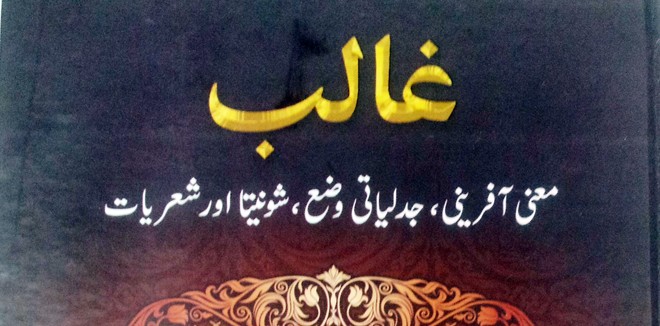

Ghalib rightly said:
"Shohrat-e-shairum bageeti baad-e-munn khahad shudan"
[My poetry will be recognised in the world, after my death].Maulana Hali was the first person to fully appreciate the subtle nuances and the multilayered meanings of Ghalib’s poetry and he wrote a detailed commentary on a selected part of it. Abdurrehman Bijnori, Nazm Tabatabai, Ikraam Sheikh and Yousuf Saleem Chishti also wrote detailed commentaries on Ghalib.
In English, J.L.Kaul’s Interpretations of Ghalib came out in 1957, in which he selected some 300 verses for interpretation. Daud Kemal, Ahmed Ali and B.N. Raina followed suit. But a major task in English was undertaken by Aijaz Ahmed who selected 37 ghazals of Ghalib, translated them into simple prose, and then handed them over to seven American poets who rendered them into English poetry.
Shamsur Rahman Faruqi and Francess Prichett’s joint venture on Ghalib has been quite useful for American and British students of Urdu literature.
Since Ghalib’s centenary year of 1969, a large corpus on the subject has been built, but Gopi Chand Narang’s book is very different in its scope and unique in approach. Ghalib has usually been associated with the Persian tradition which he was himself very proud of, but Narang has set out to explore an altogether uncharted territory in this realm: he believes that Ghalibian thought, which is postmodern by nature, is pre-historic in its origin and the roots can be traced back to the ancient Indian philosophies of Vedanta and Shunniyta -- the Buddhist concept of Nothingness.
Obviously, it’s a maverick approach and the skeptics cannot digest it right away but, on Narang’s part, it is not just a random thought. He has taken great pains to thoroughly study the local and Persian sources. He has re-read the entire poetry of Ghalib in chronological order, tracing the incoming influences, step by step. It is an already well-established fact that Ghalib’s early poetry is highly influenced by Abdul Qadir Bedil, a Persian language poet of Indian origin. Before moving any further letbe clear on this particular class of Indian poets.
Iranians divide the classical Persian poetry into three categories: Khorasani School, Iraqi School, and Indian School. Firdousi, Rodki, Unsuri and Roomi represent the Khorasani school while Hafiz, Saadi, and Amir Khusro belong to Iraqi School. The Indian School, or "Subk-e-Hindi" has a long list of poets, including Fughani Shirazi, Nazeeri, Urfi, Faizi, Talib, Kaleem, Saaeb, Ghani Kashmiri, Bedil and of course Ghalib.
Khorasani and Iraqi schools are known for their simplicity and directness, and are closer to the folklore in their nature while Subk-e-Hindi is famous for its sophisticated language, pompous expression, a rather complicated system of similes and metaphors, and an overall grandeur of expression.
Ghalib started composing poetry at an early age of 11 and by the time he was 15, Ghalib was already an accomplished poet, both in Urdu and Persian. He was heavily influenced by Bedil and used long-winded complex metaphorical phrases with complicated genitive and attributive compounds. Gradually, he came out of this linguistic complexity and verbal jugglery and started using simple and plain language. However, this simplicity was limited only to the outer form of his expression. In the deep structure he was as complicated as ever. This characteristic of complexity came directly from Bedil, and Bedil himself derived it from ancient Indian thought.
Quoting Ray Billington, Dhirendra Sharma and B.K. Matilal, Narang explains the basic concepts of Brahma, Nirvan, Mukti, Bhav, Abhav and Padarth. He also goes into minute details of how the negative dialectics of Shooniyta works, and how it differs from the concept of Maya, but in the final analysis his whole stress is on the point that Bedil seems to have studied these ancient texts, probably in Persian translations, and so thoroughly absorbed the theory of negative dialectics that it became a part of his thought process and consequently a recurrent theme in his poetry.
There is no clear indication that Mirza Ghalib had direct access to primary sources of Hindu and Buddhist ancient texts such as Yogavasistha. But Narang strongly suggests that Ghalib internalised the philosophy of Maya and Shooniyta indirectly, through the verse of Bedil which was fully drenched in these philosophies. Narang generously quotes from Bedil’s poetry and also gives us enough material from the Persian and Urdu stock of Ghalib, so that we can easily compare the two and draw our own conclusions.
The book is divided into 12 well-developed chapters. In Chapter 11, Gopi Chand Narang discusses the difference between Marxian dialectics, Sufi dialectics, Buddhist dialectics, and the way Ghalib’s inherent ‘negative dialectics’ works during his creative process. At this point he, once again, explains how Saussure and Derrida’s 20th century theories become relevant in the Ghalib discourse.
Narang must be praised for his unambiguous language which explains every point with full clarity and even at the risk of repeating himself. As a sympathetic class teacher, he is always concerned about the last boy on the last desk, and periodically checks if the boy can hear him loud and clear.